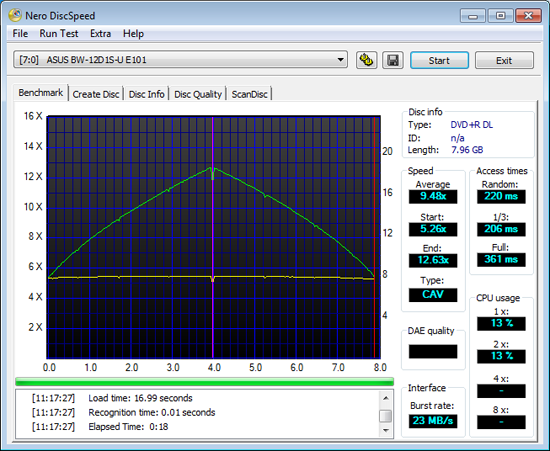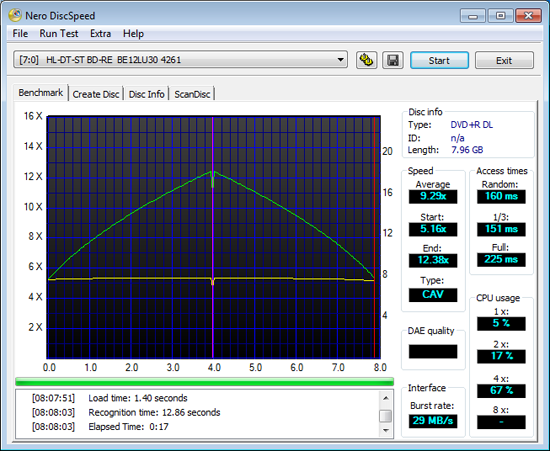Three External USB And eSATA Blu-ray Burners Tested
The advent of affordable, high-capacity media could bring a renaissance in optical storage, but only if the performance is adequate. We tested a few of today’s fastest drives with USB and eSATA connectivity to find out where this technology stands.
DVD+R Dual-Layer Read Performance
While slower reads and writes are expected from dual-layer media, several of our tests show that the optical parts of these drives are often able to keep up with the mechanical parts.
Asus drops almost to the 12x maximum that its rating suggests, though we were hoping to see the single-layer data rate mirrored. A 9.48x average is the result.
LG falls slightly below Asus at 9.29x average.
Plextor falls slightly below LG at 9.07x in tight competition.
DVD data rates are well below the LG BD12LU30’s USB 2.0 limit, so we see identical performance on its alternative interface.
Plextor’s alternative interface is likely the more native connection, yet we don’t see any performance benefit from using it with dual-layer DVDs.
Get Tom's Hardware's best news and in-depth reviews, straight to your inbox.
Current page: DVD+R Dual-Layer Read Performance
Prev Page DVD-R Single-Layer Read Performance Next Page A Big Performance Surprise!-
Crashman pirateboyno LiteOn device? why?The eHBU212 wasn't available yet when this roundup was initiated last spring. Sorry, other reviews had deadlines.Reply -
Could you please add a chart about the quality of the burned data itself.Reply
(I do not know if this is possible?) A lot of people still burn audio CDs and for this the burn quality is normally essential -
Crashman Mille23Could you please add a chart about the quality of the burned data itself.(I do not know if this is possible?) A lot of people still burn audio CDs and for this the burn quality is normally essentialIt's in the photo album:Reply
http://www.tomshardware.com/gallery/bd-sl-scan-ASUS,0101-302721-9789-0-0-0-jpg-.html See no errors know no errors. -
Crashman dimarWhen do we finally get eSATAp?It's been replaced with USB 3.0, and neither of those has enough amperage to power these drives.Reply -
dimar CrashmanIt's been replaced with USB 3.0, and neither of those has enough amperage to power these drives.Reply
Not true. http://en.wikipedia.org/wiki/ESATAp
I already have the bracket for eSATAp where I have the power supply connected using the 12v/5v molex cable. -
Crashman dimarNot true. http://en.wikipedia.org/wiki/ESATApI already have the bracket for eSATAp where I have the power supply connected using the 12v/5v molex cable.That's fine, but it doesn't contradict what I said.Reply
Let me be more specific: USB 3.0 is primarily for portable devices, eSATA is primarily for stationary devices, and eSATAp is something in the middle that doesn't have enough power for "big" drives such as these.
The purpose of eSATAp WAS to combine the convenience of USB 2.0 with the performance of eSATA. But the purpose of USB 3.0 IS to combine the convenience of USB 2.0 with the performance of PCIe. This is a was vs is debate, Windows XP is still great too but many people have simply quit using it.
Hey, I remember external SCSI too!
BTW, some of these drives DO support eSATA. Forget the P, a USB power connector won't power these drives! -
dimar CrashmaneSATAp is something in the middle that doesn't have enough power for "big" drives such as these.Reply
You don't get it. You actually connect the power supply power cable to the back side of the eSATAp connector. It gets the full 12v and 5v load.





